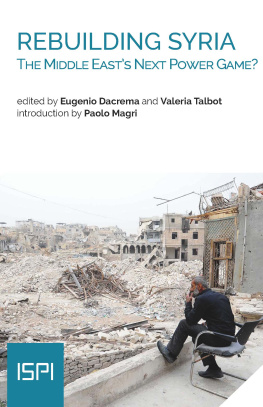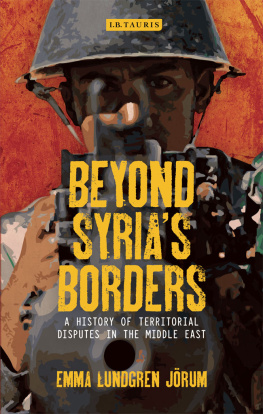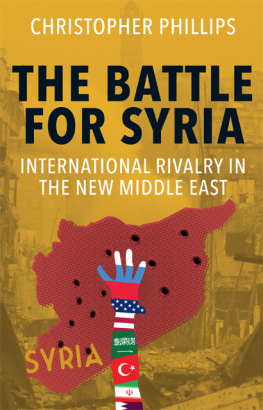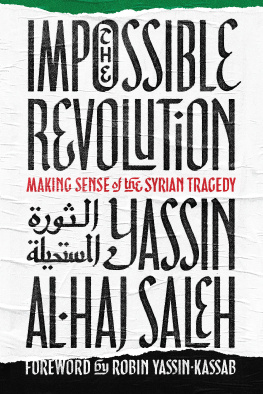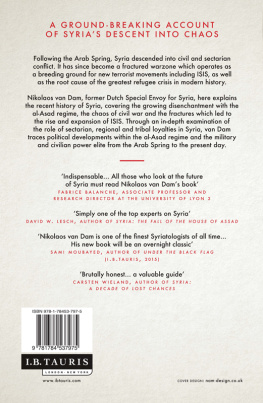ROUTLEDGE LIBRARY EDITIONS: SYRIA
Volume 4
SYRIA UNDER ASSAD
SYRIA UNDER ASSAD
Domestic Constraints and Regional Risks
Edited by
MOSHE MAOZ
AND AVNER YANIV
First published in 1986
This edition first published in 2014
by Routledge
2 Park Square, Milton Park, Abingdon, Oxon, OX14 4RN
and by Routledge
711 Third Avenue, New York, NY 10017
Routledge is an imprint of the Taylor & Francis Group, an informa business
1986 Moshe Maoz and Avner Yaniv
All rights reserved. No part of this book may be reprinted or reproduced or utilised in any form or by any electronic, mechanical, or other means, now known or hereafter invented, including photocopying and recording, or in any information storage or retrieval system, without permission in writing from the publishers.
Trademark notice: Product or corporate names may be trademarks or registered trademarks, and are used only for identification and explanation without intent to infringe.
British Library Cataloguing in Publication Data
A catalogue record for this book is available from the British Library
ISBN: 978-0-415-83882-5 (Set)
eISBN: 978-0-203-77927-9 (Set)
ISBN: 978-0-415-73500-1 (Volume 4)
eISBN: 978-1-315-81894-8 (Volume 4)
Publishers Note
The publisher has gone to great lengths to ensure the quality of this reprint but points out that some imperfections in the original copies may be apparent.
Disclaimer
The publisher has made every effort to trace copyright holders and would welcome correspondence from those they have been unable to trace.
SYRIA UNDER ASSAD
Domestic Constraints and Regional Risks
Edited by MOSHE MAOZ and AVNER YANIV
1986 Moshe Maoz and Avner Yaniv
Croom Helm Ltd, Provident House, Burrell Row,
Beckenham, Kent BR3 1AT
Croom Helm Australia Pty Ltd, Suite 4, 6th Floor,
6476 Kippax Street, Surry Hills, NSW 2010, Australia
British Library Cataloguing in Publication Data
Syria under Assad: domestic constraints and regional risk.
1. Syria Politics and government
I Maoz, Moshe II. Yaniv, Avner
956.91-042 DS98.2
ISBN 0-7099-2910-2
Printed and bound in Great Britain by
Biddies Ltd, Guildford and Kings Lynn
CONTENTS
This collection of studies is the harvest of a one-day symposium held at the University of Haifa in January 1984. The initiative came from the Universitys Institute of Middle Eastern Studies. Bearing the name of Gustav Heinemann, the late President of the Federal Republic of Germany, the IMESH is an interdisciplinary meeting ground for researches in Islamic studies, Arab history and culture, politics and international relations in the Middle East, ethnic relations, the social psychology of international conflicts, the political geography of conflict and problems of education in a conflict environment.
Every year, and occasionally more than once a year, the IMESH holds a large symposium. In 1984 it was the turn of the political scientists and area specialists to design a meeting. And since Syria was in the news and there was tremendous public interest in its history, domestic problems and, above all, role as an actor on the Middle Eastern scene, a symposium on it appeared to be a timely and promising idea.
Initially the objectives were rather modest. No one, to put it bluntly, had any intention of going beyond a learned exchange of views for the benefit of the campus audience. But once the conference was held it turned out that the quality of the presentations, the main recurrent themes and the uniquely synoptic panorama of the Syrian scene which the presentations offered had the potential of an interesting book. Concerned to avoid quick outdating of the papers, we requested the contributors to add onto the bones of their analyses as much factual flesh as they could without presenting the publisher with an over-long manuscript. Most of the contributors responded to the challenge with such enthusiasm that we found ourselves inundated with enough material for two volumes. Consequently, we had no alternative but to cut many of the articles to almost half their size in the original form. This was a painful phase and it is a tribute to the patience and generosity of the contributors that we succeeded in completing the task in the same spirit of co-operation and good will which had characterised the enterprise at the very beginning.
But while the creative enthusiasm of scholars is a sine qua non for a good book, it is not at all a sufficient condition, especially when the book holds many articles by different authors coming from various scholarly traditions, teaching at different universities, writing in a variety of languages, and either living in three different continents or, worse still, constantly on the move among them. To edit a book under these conditions is a nightmare unless one has the assistance of administrative and editorial staff of the calibre which we were fortunate to have at the IMESH. Among them three individuals deserve a special tribute. The first is Mr. Asher M. Goldstein, the linguistic editor, who tirelessly and with an amazing skill read and re-read the manuscript in pursuit of technical and linguistic perfection. The second is Professor Arnon Soffer, a leading geographer and currently the Director of the IMESH whose support and encouragement made the project possible. The last, but by all accounts not the least, is Mrs. Sarah Tamir, the Executive Secretary of the IMESH who literally carried the project through from the symposium to the edition. Throughout the two years in which the book was in the making she showed ingenuity, tact and charm, a rare combination of qualities without which it would probably take longer to produce a far less gratifying result.
The Editors
Haifa
Moshe Maoz and Avner Yaniv
Research on Syria has evolved in three fairly distinct perspectives. The first, and so far most elaborate, has focused primarily on politics and society within the Syrian state. Scholars in this area have concerned themselves primarily with the power struggle that has dominated Syrian politics since the inception of an independent Syrian polity. What were the traits of the generation of leaders who received the reins of power from the French? What were the causes and the consequences of the succession of coups dtat which took place between 1949 and 1963? What were the social bases of the new political and military elites which took over from the ancien rgime during the 1950s? What were the emerging patterns of relations between the rising military, on the one hand, and the politicians, on the other hand? What were the social, ideological and personal origins of the power struggle among the Sunnis, the Alawis, the Druzes and the Christians and within each one of these religiously distinct communities, both before and after the advent of the Baath? What were the socio-economic and political relations between town and country and among Syrias competing regional centres? Finally, and perhaps most important of all, has a genuine political community emerged in the Syrian state? Or has Syria remained a largely artificial administrative edifice, hopelessly caught between the magnetic attraction of Pan-Arabism, on the one hand, and the even more vigorous attraction of local, particularist loyalties, on the other hand?1


